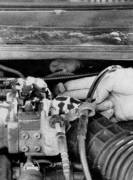|
Vacuum Leaks
First,
we checked for vacuum leaks and cleaned the idle stabilizer valve.
Almost any hose under the hood is a good candidate for a leak.
Pay particular attention to those on the back side of the engine,
where things get hot. As a precaution we usually replace the
factory cloth-covered rubber hoses with long-lasting silicon
tubing. Ron stocks this good stuff, which seems to last forever.
It's a nice shade of blue, too. A foot or too will replace all
the little bits and pieces from the throttle body to ventilation
system and to the spark computer.
Cleaning the idle stabilizer
valve was as simple as removing the hoses from the valve, and
spraying carb cleaner in to remove any excess oil blow-by or
gunk. We then replaced the hoses.
We looked at the hoses that
connect the brake booster, the breather hose, and idle stabilizer.
It's especially important to check the rubber O-ring seals around
the injectors, a common source ofleaks. We also checked out the
boot connecting the metering unit and the throttle valve. This
is especially a problem on the 8V A2 GTIs and Jettas, although it
usually causes drivability problems instead of a bad idle. It
can be caused by a bad motor mount, by the way.
Ron used a professional trick
that you can easily duplicate to help diagnose hard to find leaks.
He sprayed carb cleaner on the idle stabilizer valve joints,
and at each of the hoses, as well as in the injector sockets.
Why? The carb cleaner is a fast burning hydrocarbon, and if there
was a vacuum leak, we would know immediately by the idle speeding
up as the carb cleaner is sucked in and burns. Keep carb cleaner
away from the exhaust manifold, by the way, and only work in
a well ventilated place.
The Next Step: Check the Idle
Setting
If
everything checked out okay with the vacuum hoses and the idle
is still bad, we're ready to proceed with the next step, checking
the basic idle setting. CIS-E cars can have the idle accurately
adjusted with a simpie duty cycle or dwell meter.
|
You
remember dwell meters, right? They used to be needed to adjust
ignition points back in the dark ages. While they sell special
duty cycle meters, you can buy an inexpensive dwell meter to
do the job. You may even find one at a garage sale for a few
bucks. The 90" scale on a dweli meter equals the 100% scale
on a duty cycle meter. That means that 45" dwell = 50% duty
cycle.
- You
connect the test leads of the dwell meter to the duty cycle test
connector. The connector is iocated in the harness by the ignition
coil, two wires in a nylon connector with a plug.
-

Uncover the connector, and
insert the test leads from the dwell meter into the connector.
Don't force too large a test lead as it could damage the connector.
We've found it handy to insert a couple of finish nails or paper
clips to make the connection easier.
The
test procedure requires a few changes. There is a charcoal canister
"T" fitting in the air flow sensor boot. Remove the
"T" and turn it to insert the side with the 1.5 mm
restrictor hole. (See photo) The crankcase breather hoses can
be either clamped shut, or disconnected. Start the engine (it's
warm, right?) and check the duty cycle.
The
correct duty cycle setting for all cars we're discussing here
is 26-30% duty cycle, or 23-27" dwell. Ifit's in the ball
park, it's time to go on to the next step after unclamping the
breather hose and returning the "T" fitting to its
correct position.
|
